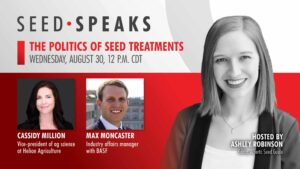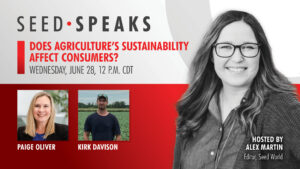When it comes to seed treatment policy, the headaches come from misunderstandings.
Seed treatments do a lot of good for crops, such as protecting seeds from pests and diseases. And while the pros of seed treatments may seem like a simple fact for some, for others there is a lot of confusion surrounding them, which may lead to regulatory issues.
“When we think about seed treatments, in terms of crop protection, we’re really thinking about how well they can reduce disease incidence. And they do that by providing an active ingredient that can be systemic throughout the plant and moving through the plant, or a zone of protection right around that seed,” Cassidy Million, vice-president of ag science at Heliae Agriculture, said during the Aug. 30 episode of Seed Speaks.
Overall, seed treatments are being used more today than they have been in the past, Max Moncaster, manager of public affairs with BASF, explained during the episode. This means growers are seeing the positive impacts from seed treatments, but there are some regions where those benefits have been questioned.
“There have been some states that have looked at trying to restrict the use of treated seeds, taking a more critical view and propose legislation that would take these tools away from growers. For us (at BASF), we want to have as many tools on the market as possible for growers to be able to use,” Moncaster added.
When access to seed treatments is limited, it can impact how producers are able to sustainably grow crops and therefore produce food. The small amount of active ingredient that seed treatments provide to plants can allow for fewer passes of tractors and other equipment across fields, Million said.
“There are new technologies hitting the market, and these are really exciting from a sustainability perspective because they’re giving us an alternative to either plant protection or increasing plant health. So potentially, this could reduce inputs later in the season, because we’re getting that benefit up front,” she added.
It’s important that these benefits are shared with policy makers to allow for continued access to seed treatments. In the past, Moncaster has found that misunderstandings around the economic and environmental value of seed treatments can lead to policy proposals that aren’t based on the realities growers are facing in their fields.
“The states and provinces where we’ve seen proposed restrictions on the use of seed treatments, I think it really doesn’t come from a malicious place, just comes from a lack of awareness and understanding about either how the products are regulated, or the value that they provide to growers,” he added.
Farmers are businesspeople and are focused on their bottom lines, Moncaster said. The products they buy and use, such as seed treatments, must have economic and environmental benefits, and in some cases provide risk insurance policies before they will purchase them.
Seed treatments are “a critical tool to have in the toolbox. We’ve got to have them available and for growers to be able to use them. But certainly, I think sometimes with that lack of understanding, you see policy proposals that would restrict access, and we need to push back really strongly,” Moncaster added.











